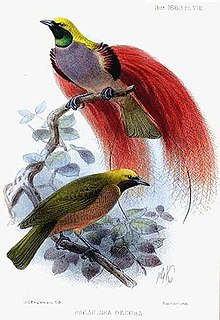
Sexual selection is a mode of natural selection in which members of one biological sex choose mates of the other sex to mate with, and compete with members of the same sex for access to members of the opposite sex. These two forms of selection mean that some individuals have greater reproductive success than others within a population, for example because they are more attractive or prefer more attractive partners to produce offspring. Successful males benefit from frequent mating and monopolizing access to one or more fertile females. Females can maximise the return on the energy they invest in reproduction by selecting and mating with the best males.

The southern platyfish, common platy, or moonfish is a species of freshwater fish in family Poeciliidae of order Cyprinodontiformes. A live-bearer, it is closely related to the green swordtail and can interbreed with it. It is native to an area of North and Central America stretching from Veracruz, Mexico, to northern Belize.

Sexual dimorphism is the condition where the sexes of the same species exhibit different characteristics, particularly characteristics not directly involved in reproduction. The condition occurs in most animals and some plants. Differences may include secondary sex characteristics, size, weight, colour, markings, or behavioural or cognitive traits. These differences may be subtle or exaggerated and may be subjected to sexual selection and natural selection. The opposite of dimorphism is monomorphism, which is when both biological sexes are phenotypically indistinguishable from each other.

A lek is an aggregation of male animals gathered to engage in competitive displays and courtship rituals, known as lekking, to entice visiting females which are surveying prospective partners with which to mate. A lek can also indicate an available plot of space able to be utilized by displaying males to defend their own share of territory for the breeding season. A lekking species is characterised by male displays, strong female mate choice, and the conferring of indirect benefits to males and reduced costs to females. Although most prevalent among birds such as black grouse, lekking is also found in a wide range of vertebrates including some bony fish, amphibians, reptiles, and mammals, and arthropods including crustaceans and insects.
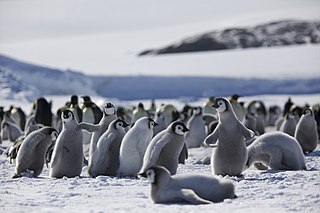
Behavioral ecology, also spelled behavioural ecology, is the study of the evolutionary basis for animal behavior due to ecological pressures. Behavioral ecology emerged from ethology after Niko Tinbergen outlined four questions to address when studying animal behaviors: What are the proximate causes, ontogeny, survival value, and phylogeny of a behavior?
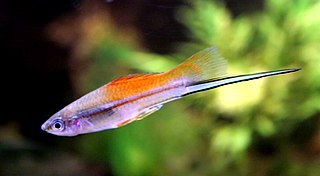
Xiphophorus is a genus of euryhaline and freshwater fishes in the family Poeciliidae of order Cyprinodontiformes, native to Mexico and northern Central America. The many Xiphophorus species are all known as platyfish and swordtails. Platyfish formerly were classified in another genus, Platypoecilia, which is now obsolete. The type species is X. hellerii, the green swordtail. Like most other new world Poeciliids, platies and swordtails are live-bearers that use internal fertilization and give birth to live young instead of laying eggs like the bulk of the world's fishes. The name Xiphophorus derives from the Greek words ξίφος (dagger) and φόρος (bearer), referring to the gonopodium on the males. All are relatively small fishes, which reach a maximum length of 3.5–16 cm (1.4–6.3 in) depending on the exact species involved.

Sperm competition is the competitive process between spermatozoa of two or more different males to fertilize the same egg during sexual reproduction. Competition can occur when females have multiple potential mating partners. Greater choice and variety of mates increases a female's chance to produce more viable offspring. However, multiple mates for a female means each individual male has decreased chances of producing offspring. Sperm competition is an evolutionary pressure on males, and has led to the development of adaptations to increase males' chance of reproductive success. Sperm competition results in a sexual conflict of interest between males and females. Males have evolved several defensive tactics including: mate-guarding, mating plugs, and releasing toxic seminal substances to reduce female re-mating tendencies to cope with sperm competition. Offensive tactics of sperm competition involve direct interference by one male on the reproductive success of another male, for instance by physically removing another male's sperm prior to mating with a female. For an example, see Gryllus bimaculatus.
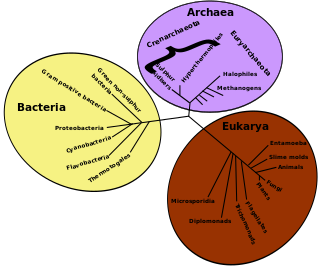
Evolutionary ecology lies at the intersection of ecology and evolutionary biology. It approaches the study of ecology in a way that explicitly considers the evolutionary histories of species and the interactions between them. Conversely, it can be seen as an approach to the study of evolution that incorporates an understanding of the interactions between the species under consideration. The main subfields of evolutionary ecology are life history evolution, sociobiology, the evolution of interspecific interactions and the evolution of biodiversity and of ecological communities.

Disruptive selection, also called diversifying selection, describes changes in population genetics in which extreme values for a trait are favored over intermediate values. In this case, the variance of the trait increases and the population is divided into two distinct groups. In this more individuals acquire peripheral character value at both ends of the distribution curve.

Anisogamy is a form of sexual reproduction that involves the union or fusion of two gametes that differ in size and/or form. The smaller gamete is male, a sperm cell, whereas the larger gamete is female, typically an egg cell. Anisogamy is predominant among multicellular organisms. In both plants and animals gamete size difference is the fundamental difference between females and males.

Sexual conflict or sexual antagonism occurs when the two sexes have conflicting optimal fitness strategies concerning reproduction, particularly over the mode and frequency of mating, potentially leading to an evolutionary arms race between males and females. In one example, males may benefit from multiple matings, while multiple matings may harm or endanger females, due to the anatomical differences of that species. Sexual conflict underlies the evolutionary distinction between male and female.

Mate choice is one of the primary mechanisms under which evolution can occur. It is characterized by a "selective response by animals to particular stimuli" which can be observed as behavior. In other words, before an animal engages with a potential mate, they first evaluate various aspects of that mate which are indicative of quality—such as the resources or phenotypes they have—and evaluate whether or not those particular trait(s) are somehow beneficial to them. The evaluation will then incur a response of some sort.
The yellow swordtail is a species of freshwater fish in the family Poeciliidae. It is endemic to the upper Coatzacoalcos River basin in southern Mexico. It is typically found in brooks and streams with slow current; it is less frequent in areas with strong current. The yellow swordtail is considered a threatened species by Mexican authorities. It reaches up to 5.1 cm (2.0 in) in standard length.

The marbled swordtail is a species of freshwater fish in the family Poeciliidae. It was endemic to the Rio Salado system in Coahuila, northeastern Mexico. It was restricted to springs, connected creeks and pools in waters with a pH slightly above neutral and temperatures of 16–26 °C (61–79 °F), with captive studies indicating that the optimum temperature is around 24 °C (75 °F).
The Chiapas swordtail or upland swordtail is a species of livebearing freshwater fish of family Poeciliidae, and genus Xiphophorus. It is, therefore, in the same genus as the common platy and the swordtail. The Chiapas swordtail was discovered and first described by Donn E. Rosen in 1960, along with four other species of Xiphophorus.

Paracerceis sculpta is a species of marine isopod between 1.3 millimetres (0.05 in) and 10.3 mm (0.41 in) in length. The species lives mainly in the intertidal zone, and is native to the Northeast Pacific from Southern California to Mexico, but has since been introduced to many other countries. Adults are herbivorous and consume algae but juveniles are carnivorous and consume moulting females. They reproduce in sponges but do not feed near them.
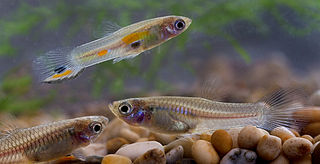
The guppy, also known as millionfish and rainbow fish, is one of the world's most widely distributed tropical fish and one of the most popular freshwater aquarium fish species. It is a member of the family Poeciliidae and, like almost all American members of the family, is live-bearing. Guppies originate from northeast South America, but have been introduced to many environments and are now found all over the world. They are highly adaptable and thrive in many different environmental and ecological conditions. Male guppies, which are smaller than females, have ornamental caudal and dorsal fins. Wild guppies generally feed on a variety of food sources, including benthic algae and aquatic insect larvae. Guppies are used as a model organism in the fields of ecology, evolution, and behavioural studies.
Xiphophorus nezahualcoyotl, the mountain swordtail, is a live bearing fish in the family Poeciliidae. It is endemic to the northwestern Pánuco River basin in Mexico. The specific name of this fish refers to the poet, philosopher and emperor of Texcoco, Nezahualcoyotl (1402-1472).
Xiphophorus malinche, also known as highland swordtail, is a live bearing fish in the family Poeciliidae. It is endemic to the Pánuco River basin in east-central Mexico. This species is named after La Malinche, an Indian slave who played a role in the Spanish conquest as the interpreter, secretary, and mistress of Hernando Cortes.
An alternative mating strategy is a strategy used by male or female animals, often with distinct phenotypes, that differs from the prevailing mating strategy of their sex. Such strategies are diverse and variable both across and within species. Animal sexual behaviour and mate choice directly affect social structure and relationships in many different mating systems, whether monogamous, polygamous, polyandrous, or polygynous. Though males and females in a given population typically employ a predominant reproductive strategy based on the overarching mating system, individuals of the same sex often use different mating strategies. Among some reptiles, frogs and fish, large males defend females, while small males may use sneaking tactics to mate without being noticed.














